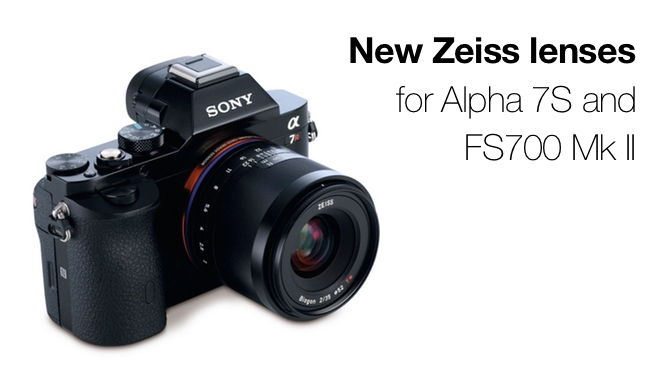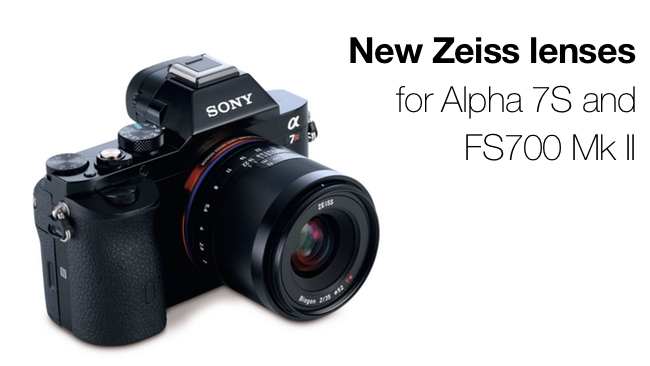
 Zeiss Loxia lenses
Zeiss Loxia lenses
A new range of lenses from Zeiss should please photographers and film makers alike
Zeiss lenses are famous for their precision and clarity, so the news that they've produced a new range, "Loxia" specially optimised for digital sensors in mirrorless cameras is likely to be welcomed by photographers and video makers. The lenses are also optimised for digital viewfinders, passing all relevant metadata to the camera as the lens is adjusted.
We have recently seen a very successful coupling of a Zeiss lens with a Sony camera in the RX10. The lens is what, in our view, transforms this camera into a professional tool. It is, literally, one of the sharpest lenses we've seen.
But since it's fixed to the camera - it's no use for other devices!
These new lenses have the same promise.
De-clickable aperture ring
Other features include a de-clickable aperture ring. This is activated with a special tool that switches modes.
Apparently, for those who prefer to turn off the camera's automation, the lenses make manual focusing easy.
There's a high resolution across the entire range, with a maximum aperture of f/2 for a high quality bokeh.
Zeiss uses pictures of Sony's Alpha 7S in their blog, which suggests that this camera will be a good home for the new lenses.
There's a mass of detail on Zeiss's blog, the text of which is reproduced below for convenience.
ZEISS Loxia: Setting new standards for full-frame mirrorless
With the new Loxia 2/35 and Loxia 2/50 lenses, ZEISS combines maximum image quality with classic ease of use for E-mount full-frame cameras. During photokina, which will take place in Cologne from September 16 to 21, photography enthusiasts can see and try out this new family of lenses for the first time.
“Ever since the Sony Alpha 7/7R/7S helped compact system cameras break through to the full frame, there has been a growing desire for a ‘digital manual focus‘ experience that combines the best of both worlds. With the Loxia 2/35 and Loxia 2/50, which are the first members of a new family of manual focus lenses for the E-mount full frame, ZEISS is ready to exceed those expectations,” said Christophe Casenave, Product Manager with ZEISS Camera Lenses.
The Loxia lenses offer several key highlights, including optimization for digital sensors and electronic viewfinders, the mechanical aperture setting and – for ambitious videography – the mechanical deactivation of the aperture click stops (de-click).
The Loxia family has been specially optimized for digital sensors and the functions of mirrorless E-mount full-format cameras. An electronic interface transmits lens data (EXIF), but also recognizes focus movements and, if desired, activates the camera’s magnifier function. Moreover, the Loxia lenses enable precise manual focusing and a mechanical setting of the aperture (working-aperture aperture priority). This traditional way of working can express one’s personal photo lifestyle, and open up surprising new creative possibilities to compose the image that go beyond all automation.
“If I had to describe Loxia lenses in just one sentence,” according to Christophe Casenave, “I would say, ‘tradition meets modernity’. These lenses have been designed for photographers who enjoy shooting spontaneous scenes, but without giving away the work of composing the image to the camera.”
Yet photographers are not the only ones who will enjoy the Loxia. Ambitious videographers will have at their disposal the possibility of progressive aperture settings (de-click). This will put a tool with enormous creative potential into their hands thanks to the mechanical deactivation of aperture click stops. The lenses’ precise manual focusing also makes the Loxia suitable for professional video productions.
The Loxia lenses are optimized for digital full-frame sensors, and factor the approx. 2.5 mm thick low-pass and infrared filters in, situated in front of the sensor of the corresponding Sony cameras.
As a Biogon, the optical design of the Loxia 2/35 consists of nine lens elements in six groups. With a full-frame focal length of a moderate wide angle, this lens is a specialist for nature, landscape and architectural photography. Because it has a low minimum object distance of just 0.3 meters, all the advantages of close-ups with an unusual perspective also come to the fore.
The design of the Loxia 2/50, which is based on the famous Planar, has six lens elements in four groups. As a ‘classic’ normal lens, it has a field of view that corresponds to natural eyesight. The Loxia 2/50 therefore reveals all its strengths in many different situations, from travel and family photography to photojournalism and portraiture. And with a minimum working distance of 0.37 meters, it can also be used for close-ups. The Loxia 2/50 is an uncomplicated but at the same time high-quality standard lens that photographers can keep on their camera continuously; this enables them to react flexibly to a wide range of everyday situations.
The effective isolation of motifs with a low depth of field as well as free-handed photography, even in poor lighting conditions, are just two examples of the many possibilities that both Loxia lenses offer thanks to their high speed of f/2.
The Loxia lenses were intentionally designed to be manual-focus lenses; this makes them extremely compact and therefore a perfect companion for travel and street photography. An important advantage in this respect, especially for photographers who work in these disciplines, is that they cannot be recognized right away as professionals. Using the Loxia lenses, they can capture completely true-to-life situations, without attracting attention.
The lenses offer a high resolution across the entire image field and — especially at the maximal aperture opening of f/2 — a harmonious bokeh in the background. The superb mechanical quality that ZEISS lenses are known for can also be found in the Loxia family. The smooth focus operation, with a large focus rotation angle of approximately 180 degrees, allows for the finest variations in focusing. The filter diameter is a consistent M52 across the entire lens family. The robust barrel, made entirely of metal, can withstand the rough everyday situations that professional photographers work in and ensures a long product life. In addition, the lenses have a special weather sealing at the lens mount to prevent spray water from getting between the camera and the lens.
The Loxia 2/50 will be available worldwide starting October 2014 and the Loxia 2/35 from the end of the fourth quarter of 2014. The recommended retail price of the Loxia 2/35 will be EUR 965.55* (US$ 1,299.00)* (excl. VAT) and that of the Loxia 2/50 will be EUR 713.45* (US$ 949.00)* (excl. VAT).
* Status September 2014
Tags: Technology



Comments